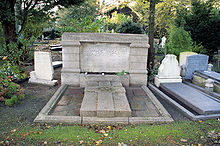Eduard Cuypers
Eduard Cuypers (April 18 1859 Roermond – June 1 1927, The Hague) was a Dutch architect.
Cuypers was trained in the architectural practice of his uncle P.J.H. Cuypers and in 1881 set up his own office in Amsterdam. His good contacts with businessmen earned him commissions for offices, shops and houses. In spite of his training by his uncle, the country's major architect of neo-Gothic, his work was closely related to Neo-renaissance and Jugendstil. Although he designed several churches, unlike his uncle and his cousin Joseph Cuypers, Eduard did not confine himself solely to ecclesiastical architecture. Instead, he designed a few dozen railwaystations, which were mostly built in the north of the country, several hospitals and many houses.

Cuypers and his employees also designed pieces of furniture and other objects for interiors, such as lamps. In 1905 Cuypers published Het Huis, Oud & Nieuw (The House, Old and New), a magazine for interior design that was published until he died in 1927.
The office of Eduard Cuypers is considered as the origin of the Amsterdam School because the leaders of this style, Michel de Klerk, Johan van der Mey and Piet Kramer, were all trained there. Berend Tobia Boeyinga, one of the most important followers of the Amsterdam school, also worked for Cuypers for a while. After Cuypers died in 1927, his office was continued by others. The current name is A/D Amstel Architects.
